The liquidity shortfall in India’s banking system has widened significantly, reaching a staggering ₹3.16 lakh crore as of Thursday, the highest level since at least 2010, according to Bloomberg Economics Index.
Economists attribute the deficit to the Reserve Bank of India’s (RBI) interventions in the forex market to stabilize the rupee. The central bank’s dollar sales to protect the rupee have absorbed substantial rupee liquidity, compounding the shortfall.
The rupee has faced mounting pressure, particularly since the November US Presidential elections, as markets anticipate inflationary trade policies under Donald Trump, reducing the likelihood of interest rate cuts by the US Federal Reserve. Additional stress has arisen from foreign institutional investor (FII) outflows due to expensive valuations, weak corporate results, and a slowing domestic economy.
RBI’s Measures to Address the Deficit
In response to the liquidity crunch, economists have called for durable liquidity infusions. The RBI has announced daily variable rate repo (VRR) auctions to inject cash into the system. Starting January 15, these auctions are conducted on all working days, with reversals scheduled for the next working day.
On Friday, the RBI announced a ₹2 lakh crore VRR auction for Monday. The central bank also conducted a 14-day VRR auction, receiving bids worth ₹1.63 lakh crore against a notified amount of ₹1.75 lakh crore. The daily VRR auction saw even higher demand, with bids totaling ₹2.22 lakh crore for a notified ₹2 lakh crore.
Economists emphasize the importance of sustained liquidity measures to address the widening gap and support the banking system amid ongoing economic pressures.



